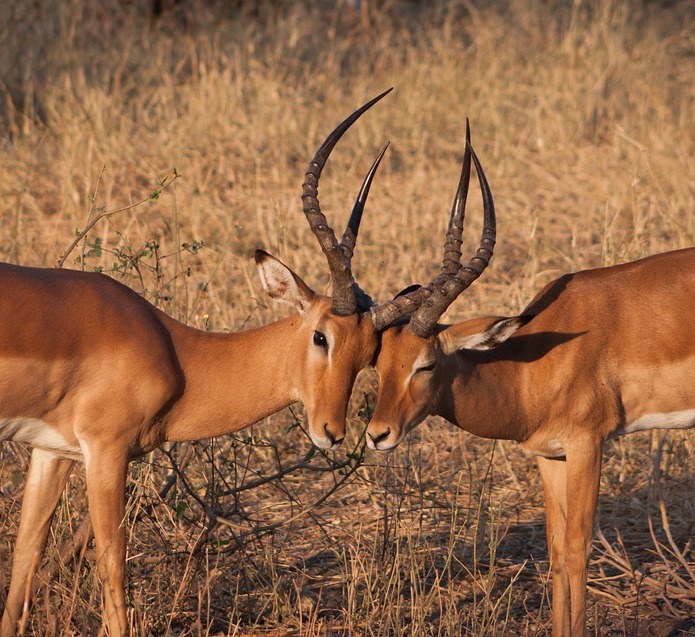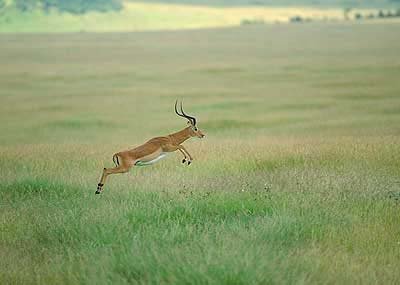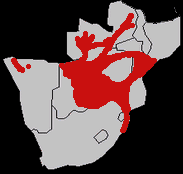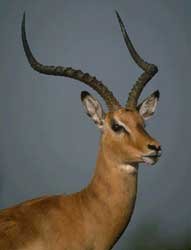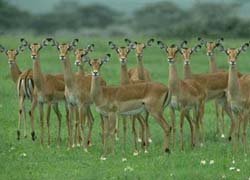The Impala, also known as Aepyceros melampus, is one of the most common and most graceful African antelopes. Slender and agile, an Impala can steer clear from formidable obstacles by running faster than 60km/hr and leaping 10m in length and 3m in height. Their impeccable speed and agility are used to prevent predation and, sometimes, just to have fun.
The Impala was first described in 1812 by German physician, botanist, zoologist, and explorer Martin Hinrich Carl Lichtenstein. The species’ first name was “Palla” or “Pallah,” which is derived from the Tswana language that means “red antelope.” The name “Impala” or “Mpala” was first attested in 1875. In Afrikaans, it can also be called as “red buck.”
This antelope species is the only member of the genus Aepyceros that belongs to the family Bovidae. Six subspecies of Impala have been initially recognized, although there are only two subspecies described based on mitochondrial and genetic differences. The two subspecies are the following:
1. m. melampus – Also known as the Common Impala, this subspecies can be found across southern and eastern Africa, from central Kenya down to South Africa and westwards into southeastern Angola.
2. m. petersi – Also known as the Black-faced Impala, this subspecies can only be seen in northwestern Namibia and southwestern Angola.
Since Impalas occur in an extensive range and their population is on a stable rise, the International Union for Conservation of Nature (IUCN) Red List categorized the species as Least Concern.
Its eight levels of scientific classification are as follows:
Kingdom: Animalia
Phylum: Chordata
Class: Mammalia
Order: Artiodactyla
Family: Bovidae
Subfamily: Aepycerotinae
Genus: Aepyceros
Species: A. melampus
The physical characteristics of an Impala
An adult Impala is a medium-sized, slender antelope that shares a similar build with Grant’s Gazelle or Kob. Its head-and-bod length measures up to 130 cm. An adult male usually weighs between 53-46 kilograms, while an adult female is lighter, weighing between 40-53 kilograms. Male Impalas have horns while females do not. A male Impalas grow slender, lyre-shaped horns that grow between 45 and 92 centimeters.
This antelope species as a glossy coat that shoes two-tone coloration—reddish-brown at the back and tan at the flanks. Both colors show distinct contrast to its white underbelly. Its facial features include white rings around the eyes, chin, and snout. Black streaks run from its buttocks to its upper hindlegs.
The distribution and habitat of Impalas
Impalas are endemic to the African continent, particularly in countries such as Angola, Namibia, South Africa, Zimbabwe, Botswana, Zambia, Mozambique, Kenya, and Tanzania. According to the University of Michigan’s Animal Diversity Web, Impalas frequent habitats such as woodlands and grasslands due to their preference for shade. These animals prefer areas with nearby water sources. Common Impalas have a wider distribution across the continent, but it has been introduced in protected areas in southern Africa and Gabon.
The behavior of Impalas
Impalas are diurnal mammals, meaning they are more active in the morning and before sunset. They are rarely seen on its own—females are with their young, while males are within bachelor groups. During the wet season, they gather in big herds of a hundred individuals. Male Impalas become territorial and will herd females around the area. On the other hand, during the hot weather, the groups roam together in search of food. Herds are exceptionally helpful for it decreases the chance of being attacked by a predator.
Males are regarded as rams, while females are called ewes. Rams produce a scent from the glands on their foreheads to establish their hierarchy within a herd. When a ram loses its rank, it produces less scent. Using their strong antlers, rams will fight against each other during the mating season.
Before a ewe gives birth, it will leave the herd. After a gestation duration of 7 months, the ewe will give birth to a single offspring called a calf. Calves are born in the middle of the day, which is deemed the safest period to give birth since most predators are resting. One or two days after birth, the ewe, together with her calf, will return to her herd. At 12 to 18 months, calves will reach sexual maturity.
The diet of an Impala
This mammal is a grazer and browser, depending on the availability of food sources. Its diet primarily consists of acacia pods, monocots, dicots, forbs, fruits, and grasses. When water is scarce, it feeds on succulent vegetation to keep hydrated.
WILDLIFE PARKS AND RESERVES WHERE THIS SPECIES IS FOUND:

